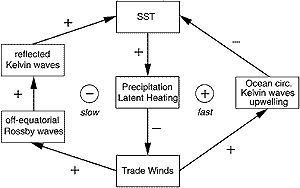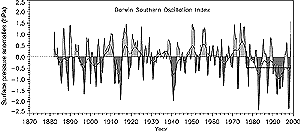7.6.5 El Niño-Southern Oscillation (ENSO)

Figure 7.8: Simplified principal feedback loops active in El Niño-
Southern Oscillation (ENSO). The fast loop (right) gives rise to an instability
responsible for the development of an El Niño, the slow loop (left)
tends to dampen and reverse the anomalies, so that together, these processes
excite oscillations. |
The strongest natural fluctuation of climate on interannual
time-scales is the El Niño-Southern Oscillation (ENSO) phenomenon, and
ENSO-like fluctuations also dominate decadal time-scales (sometimes referred
to as the Pacific decadal oscillation). ENSO originates in the tropical Pacific
but affects climate conditions globally. The importance of changes in ENSO as
the climate changes and its potential role in possible abrupt shifts have only
recently been appreciated. Observations and modelling of ENSO are addressed
in Chapters 2, 8 and 9;
here the underlying processes are discussed. Observational and modelling results
suggest that more frequent or stronger ENSO events are possible in the future.
Because social and ecological systems are particularly vulnerable to rapid changes
in climate, for the next decades, these may prove of greater consequence than
a gradual rise in mean temperature.
7.6.5.1 ENSO processes
ENSO is generated by ocean-atmosphere interactions internal to the tropical
Pacific and overlying atmosphere. Positive temperature anomalies in the eastern
equatorial Pacific (characteristic of an El Niño event) reduce the normally
large sea surface temperature difference across the tropical Pacific. As a consequence,
the trade winds weaken, the Southern Oscillation index (defined as the sea level
pressure difference between Tahiti and Darwin) becomes anomalously negative,
and sea level falls in the west and rises in the east by as much as 25 cm as
warm waters extend eastward along the equator. At the same time, these weakened
trades reduce the upwelling of cold water in the eastern equatorial Pacific,
thereby strengthening the initial positive temperature anomaly. The weakened
trades also cause negative off-equatorial thermocline depth anomalies in the
central and western Pacific. These anomalies propagate westward to Indonesia,
where they are reflected and propagate eastward along the equator. Thus some
time after their generation, these negative anomalies cause the temperature
anomaly in the east to decrease and change sign. The combination of the tropical
air-sea instability and the delayed negative feedback due to sub-surface ocean
dynamics can give rise to oscillations (for a summary of theories see Neelin
et al., 1998). Two of these feedbacks are schematically illustrated in Figure
7.8. Beyond influencing tropical climate, ENSO seems to have a global influence:
during and following El Niño, the global mean surface temperature increases
as the ocean transfers heat to the atmosphere (Sun and Trenberth, 1998).
|
Box 7.2: Changes in natural modes of the climate system.
Observed changes in climate over the Northern Hemisphere in winter reveal
large warming over the main continental areas and cooling over the North
Pacific and North Atlantic. This “cold ocean – warm land”
pattern has been shown to be linked to changes in the atmospheric circulation,
and, in particular, to the tendency in the past few decades for the North
Atlantic Oscillation (NAO) to be in its positive phase. Similarly, the
Pacific-North American (PNA) teleconnection pattern has been in a positive
phase in association with a negative Southern Oscillation index or, equivalently,
the tendency for El Niño-Southern Oscillation (ENSO) to prefer
the warm El Niño phase following the 1976 climate shift (Chapter
2). Because of the differing heat capacities of land and ocean, the “cold
ocean-warm land” pattern has amplified the Northern Hemisphere warming.
A fingerprint of global warming from climate models run with increasing
greenhouse gases indicates greater temperature increases over land than
over the oceans, mainly from thermodynamic (heat capacity and moisture)
effects. This anthropogenic signal is therefore very similar to that observed,
although an in-depth analysis of the processes involved shows that the
dynamical effects from atmospheric circulation changes are also important.
In other words, the detection of the anthropogenic signal is potentially
masked or modified by the nature of the observed circulation changes,
at least in the northern winter season. The detection question can be
better resolved if other seasons are also analysed (Chapter
12). Attribution of the cause of the observed changes requires improved
understanding of the origin of the changes in atmospheric circulation.
In particular, are the observed changes in ENSO and the NAO (and other
modes) perhaps a consequence of global warming itself?
There is no simple answer to this question at present. Because the natural
response of the atmosphere to warming (or indeed to any forcing) is to
change large-scale waves, some regions will warm while others cool more
than the hemispheric average, and counterintuitive changes can be experienced
locally. Indeed, there are preferred modes of behaviour of the atmospheric
circulation, sometimes manifested as preferred teleconnection patterns
(see this chapter) that arise from the planetary waves in the atmosphere
and the distribution of land, high topography, and ocean. Often these
modes are demonstrably natural modes of either the atmosphere alone or
the coupled atmosphere-ocean system. As such, it is also natural for modest
changes in atmospheric forcing to project onto changes in these modes,
through changes in their frequency and preferred sign, and the evidence
suggests that changes can occur fairly abruptly. This is consistent with
known behaviour of non-linear systems, where a slow change in forcing
or internal mechanisms may not evoke much change in behaviour until some
threshold is crossed at which time an abrupt switch occurs. The best known
example is the evidence for a series of abrupt climate changes in the
palaeoclimate record apparently partly in response to slow changes in
sea level and the orbit of the Earth around the Sun (Milankovitch changes,
see Chapter 2). There is increasing evidence that
the observed changes in the NAO may well be, at least in part, a response
of the system to observed changes in sea surface temperatures, and there
are some indications that the warming of tropical oceans is a key part
of this (see this chapter for more detail). ENSO is not simulated well
enough in global climate models to have confidence in projected changes
with global warming (Chapter 8). It is likely that
changes in ENSO will occur, but their nature, how large and rapid they
will be, and their implications for regional climate change around the
world are quite uncertain and vary from model to model (see this chapter
and Chapter 9). On time-scales of centuries, the
continuing increase of greenhouse gases in the atmosphere may cause the
climate system to cross a threshold associated with the Atlantic thermohaline
circulation: beyond this threshold a permanent shut-down of the thermohaline
circulation results (see this chapter and Chapter 9).
Therefore, climate change may manifest itself both as shifting means
as well as changing preference of specific regimes, as evidenced by the
observed trend toward positive values for the last 30 years in the NAO
index and the climate “shift” in the tropical Pacific about
1976. While coupled models simulate features of observed natural climate
variability such as the NAO and ENSO, suggesting that many of the relevant
processes are included in the models, further progress is needed to depict
these natural modes accurately. Moreover, because ENSO and NAO are key
determinants of regional climate change, and they can possibly result
in abrupt changes, there has been an increase in uncertainty in those
aspects of climate change that critically depend on regional changes.
|
|
 Figure 7.9: Darwin Southern Oscillation Index (SOI) represented
as monthly surface pressure anomalies in hPa. Data cover the period from
January 1882 to December 1998. Base period climatology computed from the
period January 1882 to December 1981. The step function fit is illustrative
only, to highlight a possible shift around 1976 to 1977.
Figure 7.9: Darwin Southern Oscillation Index (SOI) represented
as monthly surface pressure anomalies in hPa. Data cover the period from
January 1882 to December 1998. Base period climatology computed from the
period January 1882 to December 1981. The step function fit is illustrative
only, to highlight a possible shift around 1976 to 1977.
|
The shifts in the location of the organised rainfall in
the tropics and the associated latent heat release alters the heating patterns
of the atmosphere which forces large-scale waves in the atmosphere. These establish
teleconnections, especially the PNA and the southern equivalent, the Pacific
South American (PSA) pattern, that extend into mid-latitudes altering the winds
and changing the jet stream and storm tracks (Trenberth et al., 1998), with
ramifications for weather patterns and societal impacts around the world.
Another related feedback occurs in the sub-tropics. The normally cold waters
off the western coasts of continents (such as California and Peru) encourage
the development of extensive low stratocumulus cloud decks which block the Sun,
and this helps keep the ocean cold. A warming of the waters, such as during
El Niño, eliminates the cloud deck and leads to further sea surface warming
through solar radiation. Kitoh et al. (1999) found that this mechanism could
lead to interannual variations in the Pacific Ocean without involving equatorial
ocean dynamics. Currently, stratocumulus decks are not well simulated in coupled
models, resulting in significant deviations of SST from the observed (see Chapter
8, Figure 8.1).
Indices of ENSO for the past 120 years (Figure 7.9), indicate
that there is considerable variability in the ENSO cycle in the modern record.
This variability has been variously attributed to: (i) stochastic forcing due
to weather and other high-frequency “noise”, and the Madden-Julian
intra-seasonal oscillation in particular; (ii) deterministic chaos arising from
internal non-linearities of the tropical Pacific ENSO system; (iii) forcing
within the climate system but external to the tropical Pacific, and (iv) changes
in exogenous forcing (see Neelin et al., 1998 and references therein). Palaeo-proxies,
archaeological evidence, and instrumental data (see Chapter
2) all indicate variations in ENSO behaviour over the past centuries, and
throughout the Holocene. Much of this variability appears to be internal to
the Earth’s climate system, but there is evidence that the rather weak
forcing due to orbital variations may be responsible for a systematic change
to weaker ENSO cycles in the mid-Holocene (Sandweiss et al., 1996; Clement et
al., 1999; Rodbell et al., 1999). However, it appears that the character of
ENSO can change on a much faster time-scale than that of small amplitude insolation
change imposed by the Earth’s varying orbit. The inference to be drawn
from observed ENSO variability is that small forcings are able to cause large
alterations in the behaviour of this non-linear system.
Continues on next page
|